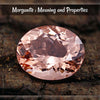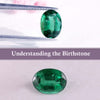
Which are the Most Expensive Birthstones?
Table Of Contents
Birthstones have long carried a sense of mystery—just like the people they represent. Across cultures and centuries, they’ve been linked to astrology, personality, and deeper meanings tied to birth months. Over time, these beliefs have shaped how we connect gemstones to human nature.
This article explores some of the most expensive birthstones, their unique qualities, and the stories that make them special.
3.95 CT Round Natural Tanzanite Engagement Ring, December Birthstone Ring
Most Expensive Birthstones of 2022
Before going further into the article, let’s first acquaint the readers with the entire list of birthstones and the associated months. Please note that the birthstones reviewed in this article are in no particular order. Okay, here goes!
● Garnets for January
● Amethysts for February
● Aquamarines for March
● Diamonds for April
● Emeralds for May
● Moonstones and Pearls for June
● Rubies for July
● Peridots for August
● Sapphires for September
● Opals and Tourmalines for October
● Citrines and Topaz for November
● Turquoise and Tanzanite for December
#1 Diamond
There is a reason why it is a widespread belief that queens are born in April. Diamond is an April birthstone, and diamonds are the most expensive gemstone with a Mohs scale reading of 10. Diamond embodies a whole life that confects wealth, health, and fortuity.
A symbol of strength and clarity, the word "diamond" comes from the Greek adamas–meaning unbreakable or invincible. Diamond birthstones are timeless. The longer you admire them, the more their rich history draws you in.
Once reserved for royalty and the elite, diamonds began circulating as trade items as early as the 4th century. They became a fashion staple in Venice by the 1400s. This marked the beginning of their rise as a global luxury. Like many trends that gained prestige in Europe, diamonds quickly became objects of fascination and desire.
As birthstones, diamonds are believed to offer protection from the evil eye, which was once thought to bring illness and misfortune. In Eastern traditions, diamond birthstones are seen as symbols of endurance and healing.
Many believe diamonds strengthen the sick. Across cultures, people value them as protectors against toxins and disease and as sources of beauty, joy, and abundance.
1 carat Pear Shaped Diamond Ring, Pear Lab Grown Diamond Halo Engagement Ring
#2 Ruby
Ruby is commonly prescribed as the July birthstone. Red is the birthstone color of fierceness, fury, and passion. Thus, rubies have long been associated with intense emotions and are among today's most sought-after gems. Rubies flaunt the highest per-carat price in the global market today.
The word "ruby" comes from the Latin ruber, meaning red. Its deep red color has long been linked to life, often symbolizing blood in ancient cultures. Christianity associates rubies with human qualities like wisdom and beauty, which helped improve their status.
Scientifically, ruby is a variety of the mineral corundum—pure aluminum oxide. What gives rubies their vibrant red color is a trace amount of chromium. Two main factors determine a ruby's quality: color and clarity.
Color is assessed through hue, tone, and saturation. While finding a ruby with a pure red hue is rare, gems are generally grouped based on these three color characteristics. Clarity refers to the number and visibility of natural inclusions within the stone. The highest-quality rubies are known as “eye-clean,” meaning they show minimal inclusions to the naked eye.
One unique feature of rubies is the presence of silk inclusions—fine intersecting lines that reflect light and add to the stone’s natural shine. These inclusions can also indicate whether a ruby has been heat-treated. This makes them helpful in evaluating authenticity and quality.
#3 Emerald
Ordained as the birthstone for May, the emerald is unanimously approved to symbolize rebirth and rejuvenation. Emerald has been an object of fascination that finds its reckoning not just bound to class representation but in prose and verse. From George RR Martin’s A Clash of Kings to comic opera, The Emerald Isle, Emerald has been a prima donna across cultures and histories.
In the past, emeralds were believed to cure several chronic illnesses, including malaria and cholera. Beyond their healing lore, emeralds have long been tied to personality traits. They’re said to inspire quick wit and sharp intelligence as a birthstone.
Emeralds also hold a special place in milestone celebrations. They are a meaningful gift for the 20th or 35th anniversary. Their royal connection runs deep—Cleopatra famously favored emeralds and often wore them in her royal jewelry. In colonial South America, the legendary Crown of the Andes featured emeralds worn by the last Inca emperor.
Like many gemstones, emeralds come with their myths and stories. Some believe placing an emerald under the tongue reveals the future. Others say the stone helps people speak more smoothly and uncover hidden truths in relationships.
#4 Blue Sapphire
The word ‘sapphire’ etymology takes us to its Greek origins. The Greek word for sapphire is sappheiros, which is usually associated with romance and symbolizes fidelity in relationships. The September birthstone is chemically corundum, with oxidative states that impart the magnificent blue color.
Sapphires carry many layers of meaning. Sapphires have held legendary status from ancient times to today. The blue sapphire represents loyalty, trust, and lasting support. Many traditions treat it as a divine stone. In ancient Persia, philosophers claimed a massive sapphire supported the Earth and made the sky appear blue through its reflection.
Throughout history, sapphires have been linked to healing powers. People once believed they could cure eye problems, skin conditions, and even boils caused by the plague. In Eastern and Western pagan cultures, sapphires were thought to ward off the evil eye—a force blamed for illness and misfortune in families and communities.
Because of these beliefs, the sapphire birthstone is often seen as a protective force and even an antidote to toxins and poisons.
2.13 TCW Round Cut with Blue Sapphire Three Stones Engagement Ring
#5 Tanzanite
A recent addition to the family of gemstones, the 20th century saw the discovery of tanzanite. This gemstone is chemically classified as a mineral zoisite. First discovered in 1962, the primary source of tanzanite is Merelani Hills. Tanzanite is most popularly known as “velvety” for its unique saturated appearance. The December birthstone occurs in a different shade of the solid colors of violet and blue. Owing to their rarity, blue tanzanite stones are the most expensive.
Tanzanite is the birthstone for December and a traditional gift for the 24th wedding anniversary. On the Mohs scale of hardness, it ranks between 6 and 7. This makes it moderately durable. However, tanzanite is sensitive to sudden temperature changes and can crack if exposed to extreme shifts.
In its natural form, tanzanite appears brown primarily. After cleaning and controlled heat treatment, it transforms into stunning shades of blue and violet—colors that give it charm and make it a perfect match for December birthdays.
Tanzanite works beautifully in designs like dangling earrings and delicate pendants. While it’s not ideal for everyday wear, a protective setting can help preserve its structure and extend its lifespan. Unlike many gemstones requiring professional care, you can safely clean tanzanite at home using warm, soapy water to remove any surface dirt or residue.
Diamondrensu is a leading jewelry manufacturer that brings its premium collection to its trusted customers. From designing weddings to birthstone jewelry, our jewelry triggers an electrifying response in our customers, making them want more!
Birthstones are a beautiful accessory to flaunt your everyday fashion repertoire. Whether you believe in birthstones, having one near you will pose no harm. A drib and a drab of extra luck are all we need in the dire straits of our lives.
Reach out to us or get your birthstone delivered to your home to feel extra lucky today!












